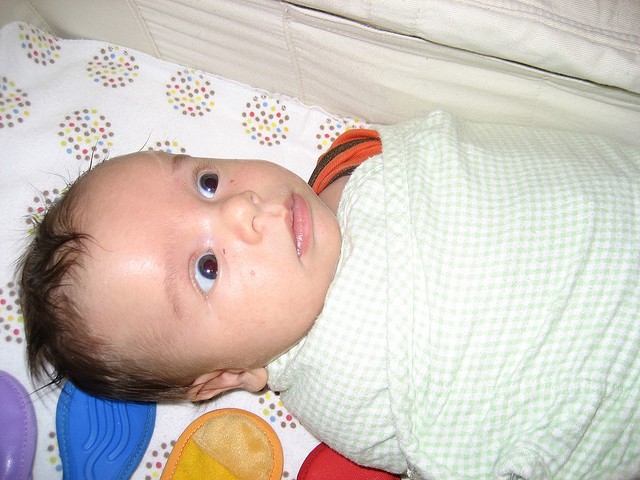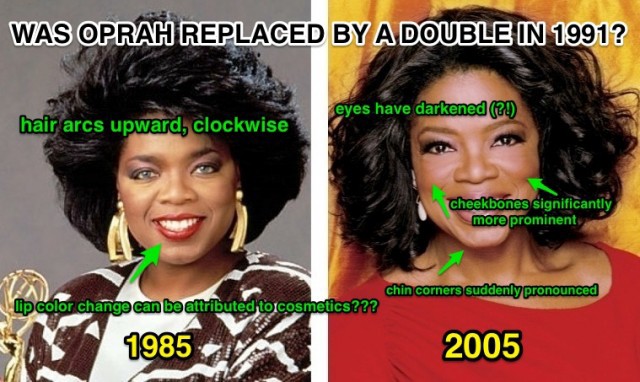To Sleep, Perchance to Scream

At three in the afternoon when my daughter was about four weeks old, I hit a wall. With my fist, though not very hard, because I was trying to be as quiet as possible. Another day that week, I went into the bathroom, all the lights turned off, and screamed into a towel. Again, I didn’t want to make very much noise, because my four-week-old daughter was “sleeping.”
There are lots of tiny and useless nuggets of wisdom parents-to-be are given. My favorite is: “Sleep when your baby sleeps.” But in the early days, she was never clearly sleeping, and any moment of silence from her corridor meant that we would panic, absolutely sure that she had SIDsed out on us. It was unclear what exactly she was doing for those twenty hours a day when she was supposedly asleep. She was noisy. So noisy. At night, she lay in her bassinet beside our bed, squawking and snorting like a young dinosaur. So I never slept. After ten or maybe fewer minutes of “rest” of my own, I’d sit up and peek over at her. If her eyes were closed when I looked, her preternatural senses alerted her that I was near and they’d fly open to make contact with mine. I’d try to feed her, change her diaper, reswaddle her. But by then she was fully awake. I’d walk her little burritoed body around, pacing, watching my husband not sleep, or sometimes, he’d do the walking while I sat there, miserable and terrified.
That’s another great bit of advice: Parents should “take turns” or “do shifts.” But every situation we encountered seemed like an emergency. She’d be crying in the bassinet next to us; she’d just lay there, wide awake, watching us; she’d need a diaper change. We’d get out the supplies, lay her on a tarp on the bed, get a thousand wipes, clean her up, put on a new diaper, swaddle her, then pick her up, only to hear the undeniable sounds of her having another bowel movement. I, the mother, who is expected to be gifted with a sense of what my baby needed, had no idea: Was she hungry? Tired? Too wet? Sick? Too dry? I was stuck in a constant and mindless cycle of trying literally anything to get her to sleep.
The last piece of wisdom that people — inevitably parents themselves — give is: “Well, say goodbye to sleeping ever again.” This is handed out with what I am tempted to call glee, a sort of “welcome to the club, it’s miserable here but so worth it!” cheering on. But when Zelda was five weeks old, I decided to reject that bit of advice. I needed to sleep, and so did she. It wasn’t out of selfishness so much as a need to actually enjoy the waking moments I had with her, which I was absolutely incapable of with zero hours of sleep per night.
Like everything else in parenting, I came to it rather willfully unprepared, but I at least knew that “sleeping” was an issue — that it was a thing which you had to have an opinion on. I formed one, and its name is sleep training.

Sleep training means a lot of things to a lot of people, but for most, it means that at some point, you begin to allow your baby to “cry it out” after putting her to bed. You leave the room — for ten minutes or an hour or even twelve — and you don’t come back, no matter what sounds you hear from within the room. Within a few nights, the sleep trainers advise — after a lot of hassle and tears on both sides of the door — your baby gets the message, and simply stops waking up. Then, magically, you have a twelve-hour-a-night sleeper. This camp argues that your baby needs to be taught how to sleep for long periods of time, and that it’s your job to guide them in that direction, often with some crying involved. They counsel that after two or three months, a baby doesn’t need to eat at night — she is simply waking out of habit, a habit which you must, at some point, break. Those opposed to sleep training argue that a baby should not be left to cry alone in her room for any period of time, because her crying signals that she needs you or wants you. Your instinctual response to a crying baby, is, of course, to go to her. But, I asked myself, at what point am I helping more than hurting? Doesn’t the baby want to sleep longer?
I chose my pediatrician, Tribeca Pediatrics, because they were the closest one to us; because Zelda was born a bit early in the middle of a blizzard; and because she needed to go to the doctor for weighing more often than a full-term newborn. But it turned out that my choice was fortuitous, because this practice, headed up by a French doctor named Michel Cohen, advocates for sleep training of babies at eight weeks old — far younger than the six months at which most experts say you should begin. I thought that I wouldn’t be able to do it when the eight-week mark came along because “sleep training” in the cry-it-out sense sounded incredibly harsh to me. But it was comforting knowing in the back of my mind that — when every day seemed to be forty-eight hours long with a baby who was either sleeping all the time or not at all (I couldn’t tell) — there was an escape hatch at the two-month anniversary, if we needed it.
But in the meantime, my researching nose kicked in and I started reading. I read Pamela Druckerman’s Bringing Up Bebé: One American Mother Discovers the Wisdom of French Parenting. It didn’t have a ton of sleeping advice, other than to let me know that most French babies are sleeping through the night by three months. The book also described vaguely something called “the pause,” where, if your baby begins making noise at night, you don’t immediately rush to her, you wait a few minutes, to see if she will “resettle” herself and go back to sleep. This seemed laughable to me, so I read on. Dr. Cohen’s book advised pretty much the same thing: Don’t rush over to your baby at the first sign of activity! See if she’s really awake! Be calm and patient. My baby appeared to be “really awake” about ninety-five percent of the time.
Then I discovered the Baby Whisperer, and her name is Tracy Hogg. Well, that was her name — she’s dead sadly, and will never receive the amazing email I penned to her one day in absolute and genuine thankfulness. Tracy Hogg’s book, published in 2001, when distilled to its essentials, amounted to this: Get your baby on a schedule. Now, Tracy didn’t call it a “schedule” because adhering to a clock isn’t really possible at first with a baby, so she called it a “routine.” The gist was this: Most moms feed their babies to sleep, and this is a no-no. A baby should eat when she wakes up, rather than when she goes to sleep, and she should eat roughly every three hours. Then, she “plays” or is active, and then she should sleep until the next time you want to feed her. The cycle lasts about three hours at first: Wake at 7 AM, eat, play until 8:30 or so, sleep until ten, wake and begin again. Tracy counselled that you should wake your baby — “never wake a sleeping baby” goes out the window — during the daytime hours, from 7 AM to 7 PM, but not the nighttime ones.
Tracy had a lot of advice about how best to get your baby to sleep: Waiting until they’re actually sleepy was the best tip. Seems so… logical… but yes, waiting until the baby is drowsy to try to put her to bed was an early and successful tip. Then swaddle her, darken the room, turn on some white noise. Don’t rock the baby to sleep. Just wait until she is very drowsy, and then put her in her crib. If she doesn’t sleep, stand by and calm her — don’t pick her up, but pat her on the tummy, let her know you’re there, and then leave (she didn’t advocate allowing her to cry, not with a baby who is five weeks old). If you do this routine day in, day out, Tracy argued, the baby would begin to go to sleep more easily, on her own, and would magically begin to sleep for longer periods of time at night. The key thing that got me on board was that, at the very least, feeding the baby every three hours would mean that I would know one thing when she cried or seemed fussy: She wasn’t hungry, she just ate an hour ago!
I wish I could say that it was easy. It wasn’t. I dutifully wrote down when she ate about every three hours, got her to sleep on about the right pattern sometimes — often after a little walking around or singing or talking to her — only to have to wake her an hour later. It was exhausting, but within about two weeks, the little bugger started waking up when it was time to eat, and to my incredulity, she did start to sleep longer at night: first four hours, then five, then magically six. Our doctor also recommended at the six-week visit that we move Zelda from our room into her own, which was tough, but we did it. She suggested that maybe our sounds (we didn’t go to bed at 7PM like her, after all) and smells were prematurely waking her. It had an immediate and positive effect, in addition to the scheduling.
By the time Zelda was eight weeks old, we went to her doctor’s appointment, expecting to hear the sleep training rigamarole: Just let her cry at night when she wakes. And we did hear it: They emailed us the video about sleep training and explained that the baby didn’t need to eat at night anymore. I explained that Zelda was now only waking once at night, and I thought that it was actually because she was hungry. The doctor said that was fine, wait until ten weeks if we wanted to, see if she sleeps through the night on her own. But, the doctor added, “You should stop walking her to sleep; stop waiting around for her.” Just do her bedtime routine — feed, bath, feed, read Dr. Seuss’s sleep book, lights out — then leave. Let her cry herself to sleep if needed.
So we did. She cried for fifteen minutes once. Most nights she was asleep before the book was finished. By the time she was nine weeks old, Zelda was only waking once a night, and going to sleep with almost no crying at all. A few days later, we had to drive to Pittsburgh for Passover. Travelling with a newborn, especially one whom you are trying to sleep train, is a nightmare even in concept, so we considered not going. We decided to give it a shot anyway, and had our family set up a travel crib in the bedroom next to ours (a key to our sleep training was that the baby couldn’t sleep in our room).
When we arrived and put her to bed in her little travel crib, she cried a bit, but not much. I stayed with her a few extra minutes. I woke at 2AM fully expecting to hear her crying, awake, but there was nothing. Silence. I went back to sleep. She didn’t wake up until 7AM. I assumed it was a fluke, but she did it the next night, and the next. Our sleep training was complete, without a night of screaming to show for it.
Since then, Zelda has woken at night about four times, all when she was getting her first two teeth. Every time it happens, I do the same thing. I “pause” to see if she is really awake, or if she is just crying randomly in her sleep. If she is truly awake, I go into her room, pick her up, cuddle her, calm her down. I read The Sleep Book (which I have memorized and don’t need the actual book for anymore) to her, and wait until she is drowsy again. I don’t feed her. I put her back to bed. And she sleeps. We vigilantly watch and listen to her on the monitor out of habit, but her sleep is calm and peaceful.
Zelda now sleeps about twelve hours a night, and another two hours during the day for naps. Sometimes, she cries her little head off for a few minutes before going to sleep, but she is reliable, and loves to sleep. And when she wakes up, whether from a nap or a night of cruising through dreamtown, she is always happy and well-rested. She is truly the happiest baby I’ve ever met.
“How does your baby sleep?” is an inevitable question you get from other parents. Sometimes, I lie about it a bit. To say that she sleeps so well sounds like a brag. It’s true, I know, that we are very lucky that Zelda took to it easily and quickly. She didn’t have colic or sleep troubles — she was like most babies, who are able to figure out, with help, how to sleep on her own at an early age. But it would be dishonest to say that I take no credit for it whatever. I did a lot of work, too, for a few long months. And of course, a lot of the credit goes to the Baby Whisperer. It would be easy for me say now that I wouldn’t have let her scream for hours on end for several nights in a row — I’m so happy and grateful that I never had to — if she had been a tougher customer in the sleep department. But I know that I would have. Because teaching Zelda to sleep is the best thing I’ve done for her yet.
Her parents sleep pretty well too.
THE PARENT RAP is an endearing new column about the fucked up and cruel world of parenting.
Laura June is a writer and a very cool mom. She is also the author of “Gone Girl.”
Photo by Katy Pearce
On the Many Previous Internets
“Falstaff Press and Panurge Press were the best-known of [mail-order smut] publishers, and their books were also the best made. They make up a subgenre in the history of pornography that has largely been left behind: Too titillating to have any real scientific value, they often also had too much deflating scientific detail to be thoroughly useful to the average masturbator.”
New York City, October 20, 2014

★★★ The morning was a slightly discolored blue, like an antiqued piece of painted furniture. Haze scattered the light and made the east not even white but colorless. Downtown, a bit of mist — real or fake — floated over a damp and squalid crime scene being staged for cameras in an alley. People in the office huddled in outerwear at their computers till the smell of the heating system spread over the room. The afternoon light up Amsterdam was strong but bleak, even where it found red and green ivy spreading over a building eight stories up. Only at the end did it turn rich and golden, just before it went out. Dinner was organized and early, but nightfall was earlier.
How Amazon Solved the Problem of Work

On Wednesday, October 8th, the Supreme Court heard oral arguments in the case of Integrity Staffing Solutions v. Busk. The case pits warehouse workers Jesse Busk and Laurie Castro against their former employer. The issue at hand is time: Should minutes spent waiting to be screened at the end of the workday — Integrity manages warehouses that fulfill online shopping orders — be counted as work? If so, then shouldn’t workers be paid?
Supreme Court cases that feel ethically simple are often legally complicated; similarly, cases that make it that far and yet appear legally tidy are often ethically difficult. This case seems to fall into the former category: you have decades of opaque labor legislation through which the definition of work must be read and in the shadow of which it must be revised; you also have a specific situation in which workers reach the end of their shifts and are then effectively detained at their workplaces for up to 25 minutes, without pay, in order to be checked for stolen merchandise.
One way to understand this post-work/pre-departure limbo is in terms of incentives: If this time counted as work, it would cost Integrity Staffing Solutions a lot of money, so Integrity Staffing Solutions would be motivated to minimize it. But if this extra time doesn’t count as work, there is no direct incentive to fix anything. In that situation, Integrity’s objectives are to make sure workers aren’t stealing merchandise, and to do so at the minimum possible cost. It does not need to worry about workers’ time, because that time, which is valuable to Integrity’s efforts to prevent theft, costs them virtually nothing. Meanwhile, the value of this time to the employees has not changed. They’re not home. They’re not at their other jobs. They’re not seeing friends. They are, as far as everyone else in their lives is concerned, still at work.
In some workplaces, long term worker morale would be an additional consideration. An employer might be incentivized to make sure its employees are happy enough to stick around. Being asked to wait in long lines due to an assumption that you are hiding stolen products in your bag is the kind of thing that might make an employee think, “I don’t want to work in this place, where I am antagonized and treated as a potential criminal.”
Integrity Staffing Solutions does not seem to see itself as the the kind of employer that owes its workers anything at all. In its job listings, it portrays itself as a leader in a bold new economy:
We are the people putting people back to work. We are the leaders of the new normal and we have been since 1997. Providing jobs, solutions and a deep competence for a new economy. We supply the skills that propel life forward. We inspire individuals to find their third, fourth and their umpteenth gear. We are an engine of opportunity. We are the gateway from good to great.
Welcome to the new normal. Welcome to Integrity Staffing Solutions. Engine of Opportunity. Engine of the new economy.
This listing’s zealous tone takes on a new dimension when you consider Integrity’s star client: Amazon.
These words are likely the first thing you will read if you come across a job opening at one of Amazon’s many shipping warehouses. This holiday season, the company is planning to hire 80,000 workers on a temporary basis. Many of those people will be subject to exit searches, and they will be in no position to complain: They will be seasonal workers in need of a job. If they could easily go somewhere else, they would already be there. (This listing, for a warehouse in Kentucky, promises “Up to $11.00 per hour.”)
In the public imagination, Amazon is an online retailer and electronics company. In practice, it is a logistics firm that oversees a system through which goods move from manufacturer to warehouse to customer. Its electronic products are just physical instances of this mindset: That the Kindle solves problems for readers is secondary to its ability to solve logistical problems for Amazon, the book seller, which sees the physical book (and maybe publishers) as an inefficiency. (I would argue that the reason Amazon’s more advanced tablet and phone products haven’t succeeded is because the device’s priorities were painfully obvious to anyone who actually used them: They weren’t better than their competitors at anything other than selling you things from Amazon. They attempted to solve the company’s problems without even accidentally solving any of yours.)
Amazon’s core employees — full-time office workers who don’t have to worry about post-shift detainment — are primarily concerned with the efficiency of systems (the company’s culture is notoriously metrics-driven). They operate in the mindset of a management consultant with one permanent client. So it makes sense that warehouse work would be treated as yet another logistical problem, and a tough one. Handing the work of hiring and then releasing these many thousands of menial workers to someone else is a valid logistical strategy insofar as it makes treating employees like products a simpler proposition. Integrity Staffing Solutions interacts with Amazon in the mode the company is most comfortable with: As a supplier of goods, from which Amazon can then extract further value. In Amazon’s view, it doesn’t need workers to satisfy a demand for labor. It needs a labor solution to solve a labor problem.
It would be nice to think that the perpetuation of Integrity’s dystopian “new normal” somehow depends on the Supreme Court’s forthcoming decision, but it doesn’t. Integrity is merely claiming to be compatible with the economy as it demonstrably exists today, with an increasingly post-union, post-full-time workforce for whom long-term careers are an outdated fantasy. The Obama administration has taken Integrity’s side, in a legal brief, which surprised some labor activists but really makes quite a bit of sense: The most revered companies in the country, the startups that are notionally building the foundations of a new American economy — the explicitly logistics-oriented Uber and Airbnb and Taskrabbit — are philosophically aligned with Amazon on matters of work.
Besides, if you’re choosing allies, Amazon will probably be around in ten years. Its warehouse workers, on the other hand, will be lucky if they haven’t been replaced by robots.
Update: On Wednesday afternoon, an Amazon spokesperson sent a statement. It is reproduced here in full:
We have a longstanding practice of not commenting on pending litigation, but data shows that employees walk through post shift security screening with little or no wait.
The Beatles Never Existed
by Russell Brandom

This is a serious subject, not a joke, and this site is here to expose the actions of those who exploited these young men and defrauded us their fans. It is to defend the honor of everyone involved who did not take part in it willingly. It has become apparent to us in this extensive and painstaking research that there were never just four individual people known as “John”, “Paul”, “George”, and “Ringo” who comprised one Rock & Roll band known as “The Beatles”, and rose to fame as the world’s first supergroup. For all intents and purposes as far as we can tell, no one such group ever existed.
— The Beatles Never Existed Dot Com
The Paul-Is-Dead meme has been kicking around for decades now, based on discrepancies in certain photos and fueled by the free-floating paranoia of the White Album; Paul looks a bit taller in the later photos, it turns out, and maybe the Abbey Road cover looks a bit like a funeral procession. The only reasonable explanation, the theory goes, is that Paul was killed in 1966 and replaced by a double, canonically known as William Campbell.
But recently, a site has suggested taking the theory one step further. If there was no Paul — that is, no singular person responsible for the musical output of “Paul McCartney” between 1942 and the present — then there couldn’t really be a Beatles either. Everyone had to be in on it, which suggests they were either doubles themselves or sufficiently threatened by the threat of double-replacement that they kept quiet about it all. The Beatles as we know them, the four smiling lads having a great time playing music and being famous, never existed. It was all just a parade of doubles, orchestrated by a sinister British music establishment.
It’s a bizarre thing to think, but it’s basically right: The idea of The Beatles has been a tissue of lies for a while now, and if we have to go through a bunch of Paul Is Dead shenanigans to finally acknowledge that, then so be it. That’s not to say these four specific human beings didn’t exist (they could still exist and have doubles), but that the magical fusion of persons-into-Beatles, which in turns leads to all of these inexhaustible ideas about bands and English camaraderie and The Sixties, is basically bogus from the start. People try to gesture to this fusion all the time — Rolling Stone has practically built a house style out of it — but if you try to break down what they’re actually gesturing at, you always come away feeling you’ve been tricked.
Some of this is generational. By now everyone knows what a drag it is to be The Guy At The Party who’s telling his friend’s girlfriend she just has to listen to “Rubber Soul.” We’ve also moved from a band culture to an singer/producer culture and, applied retroactively, no more bands means no more Beatles. If you want to make the argument for George as a good songwriter or Paul as a historically important producer, someone might agree with you, but that’s different from saying that The Beatles exist.
When you move from a bunch of talented guys playing music together to a Capital-B Band, everything becomes a lie. How were these products/songs even created? According to the theory, what we see is a number of singular moments of musical genius being wrenched from their creators and swallowed by the machine of The Beatles, the great lie necessitated by the mechanics of music publicity. That is to say, someone certainly wrote “Helter Skelter,” but maybe it would get more play as a Beatles song than as a William Campbell song — so it gets fed into the Beatles machine where a hired actor, renowned for doing a great “Paul,” can give it the razzle-dazzle it needs. All these talented performers and songwriters (who, collectively, are as close to The Beatles as it gets) either disappeared or died as soon as they were no longer useful to The Machine of The Beatles, and any record of their involvement was erased.
This sounds like a post-fascist nightmare, but it’s also a reasonable and fair description of the entertainment industry as it currently exists; it is an inevitable part of the mechanics of fame. Once a person’s name becomes valuable enough, the enterprise shifts into mass production, sucking in whatever raw materials are needed to fulfill market demand. If a single individual starts to fall behind on one or more inputs, it’s easy to bring in a ghostwriter to fill in the gaps. Soon you’re running a major national magazine, your assistant is writing your editor’s notes, and your central function is to exist as a permanent branding edifice that editors and ad salesman can gesture towards when it’s strategically convenient. You see it the most in media, but the same logic applies across industries, wherever someone’s popular enough to break free from the prison of existing in a single corporeal form.

The Beatles-sized brands of 2014 are generally individual people — Letterman! Huffington! Oprah! Beyonce! — and they’re not interested in impostorship, but the basic principle is still very much in play. If you hear a memorable line from Oprah or Arianna Huffington, the chances are very strong that that line was written by a ghostwriter, hired for his-or-her talent at nailing the Oprah voice. Beyoncé doesn’t exist either, but it hasn’t stopped her from producing a fine and varied catalogue of music. It’s an interesting question whether the equivalent producers and songwriters exist. Pharrell is an easy case: He stopped existing almost immediately. The-Dream and Blood Orange are harder. Esther Dean exists right now, but if she keeps this up she could cease to exist as early as 2016.
In general, those who do not exist exploit those who do exist, so if you have to be on one side of the equation, you’d have to choose the ethereal one. Almost all of the people who have ceased to exist (without dying) have done so through great sacrifice and enduring labor. The ceasing-to-be applies retroactively, as noted above, so it’s considered a real coup to find evidence from such a person’s previous existence after the fact. It’s also notoriously difficult to go back to existing once you’ve ceased to exist, which can cause all sorts of later-life issues for the less financially secure apparitions.
The Beatles (and Beyoncé) are a special case because people really want them to exist. They seem so nice! If anyone was going to be exempt from the logic of cultural mass production, you’d think it would be them. The Paul is Dead stuff gets so much play because it pulls the rug out from under it all, a harsh reversion to the economic mean. Surely there was a time when things weren’t this way? When people existed as physical and biological creatures, rather than some economically expedient abstraction? When creating a work of art didn’t imply any larger tactical broadcast? Maybe! But it was probably just a compelling pretense, much like The Beatles themselves.
Russel Brandom is a reporter at The Verge.
Todd Terje, "Delorean Dynamite (for sale)"
A song that you can enjoy aesthetically or for its cheery thesis: That music is a subset of advertising.
Cosmic Moans, Ranked
10. Neptune moan
9. Earth moan 2 (“song”)
8. Uranus moan
7. Saturn ring moan
6. Jupiter moan
5. Saturn moan
4. Earth moan 1 (“voice”)
3. Miranda moan
2. IO moan (moon-moan)
1. Uranus ring moan
New York City, October 19, 2014

★★★★ The apartment door banged in its frame where it stood, and howling sounds came from down the hallway. Time to switch to socks that would cover the ankles. Sunlit pieces of plant fluff flared and veered in the forecourt. The pigeon spikes on the near wall were a glittering battlement. Food trucks flanked the Apple Store. Birds twittered over the generator throb. “That is not a ice cream truck!” the three-year-old said. The shortness of the afternoon was palpable. Down by Canal Street, a paper or foam plate soared up and then dived down to bounce off the windshield of a Mercedes. A foam mesh fruit sleeve rolled around on the sidewalk. The shiny parts of the Empire State Building caught the lowering sun and shimmered in the distance.
